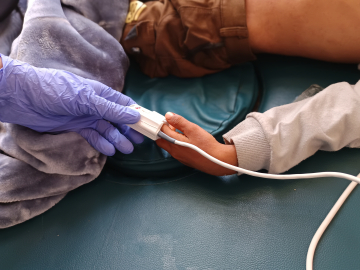What It Means When Billions of People Must Wait Years for a COVID Vaccine
One Friday last month, I posted a map on Twitter. It drew immediate global attention, was seen by 8 million people, and has provoked strong responses and anger—and hopefully some soul-searching among those in governments and pharmaceutical companies.
The map, produced by my colleagues at The Economist Intelligence Unit, depicted forecasts of when people in countries around the world could hope to have widespread access to coronavirus vaccine shots.
The projected timelines will no doubt change, but one fact will not: Developed countries will have access to coronavirus shots first, and poorer ones will need to wait longer, possibly until 2023 or even 2024. (As with all forecasting exercises, the map represents our best projections based on available knowledge at this point.)
Since then, the WHO has, unfortunately, confirmed this bleak forecast. There is a very high risk that the COVAX initiative, which aims to supply 92 low- and middle-income countries with cheap coronavirus vaccines, will not deliver vaccines for billions of people until 2024.
The angry, worried responses to the map on Twitter are revealing—and may have important implications for governments.
First, it is clear that many governments across the world have yet to tell their citizens that developing a coronavirus vaccine is just the first step towards containing the pandemic. Financing, manufacturing and distributing the shots on a global scale will be even more challenging than designing them.
There will not be enough jabs for everyone for a long time to come. Wealthier countries, which secured supply deals early on, will get access to the vaccines first. However, phased rollouts and bumps in the road mean that their general populations should not expect a shot before mid-2021, at best.
The timeline will stretch for longer in other countries. In LMICs, a lack of institutional capacity to roll out mass immunization programs, coupled with little financial resources to buy vaccines, are behind our projection for mass immunization stretching into 2024.
Second, reactions to the map show that resentment is running high across the world. In many cases, people direct their rage at their governments, asking their elected leaders to explain why they could not secure early access to the shots. Some may see this as a positive development: People are holding their governments accountable for a perceived failure. However, these comments are worrying because they point to the possibility of popular backlash and social unrest in many LMICs. The political landscape of several Asian, African or Latin American countries may well change as a result of the pandemic.
Third, people are angry at the West. Some believe that rich travelers contaminated poorer countries by refusing to stop leisure travel. In many of these tweets, condemnations of capitalism, perceived Western “imperialism,” and globalization abound.
Some comments reveal hostility and skepticism towards Western pharmaceutical firms, despite their impressive achievements in developing vaccines in record time. Other people say they are happy that their timeline for vaccination extends to 3 years because they do not want to be guinea pigs.
Some disturbing comments suggest that the US should be the last country in the world to have access to coronavirus vaccines because of its poor record at containing the pandemic. Very few replies, however, mention China’s early failure to be transparent or to mitigate the outbreak.
In fact, there appears to be much hope across the world that Chinese and Russian vaccines will come to the rescue of lower-resource countries, for free. This is an interesting twist, as there is still a dearth of reliable scientific data regarding these vaccines.
It is also unlikely that Beijing and Moscow would provide their vaccines to lower-resource countries with no strings attached. For many poorer countries, getting a seemingly cheap deal to receive Chinese-made vaccines may represent the first step towards increased dependency on China.
Overall, the response to our map from around the world paints a bleak picture. After months of lockdown, people are exhausted, angry, and resentful. The ripple effects of the pandemic will continue well after vaccines are widely available, whenever that is.
Agathe Demarais is Global Forecasting Director for The Economist Intelligence Unit.
For the latest, most reliable COVID-19 insights from some of the world’s most respected global health experts, see Global Health NOW’s COVID-19 Expert Reality Check.
Join the 50,000+ subscribers in 170+ countries who rely on Global Health NOW summaries and exclusive articles for the latest public health news. Sign up for our free weekday enewsletter, and please share the link with friends and colleagues: https://www.globalhealthnow.org/subscribe
A worker displays syringes at the Hindustan Syringes factory in Faridabad as India ramped up production ahead of a coronavirus vaccine rollout. September 2, 2020 Image: Sajjad Hussain/AFP/Getty





